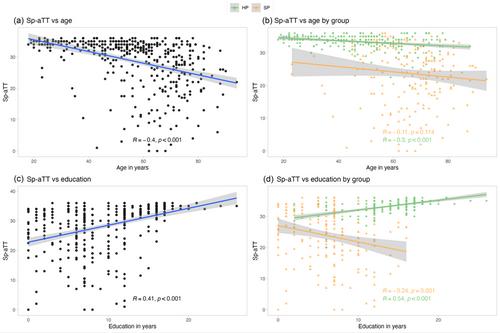Validation of the abbreviated version of the Token Test in Latin American Spanish stroke patients
Abstract
Background
The abbreviated version of the Token Test (aTT) is widely used to assess language comprehension deficits in stroke patients (SPs). However, aTT has not been validated for Latin American Spanish speakers, so clinicians tend to use cut-off scores for aTT validated in developed countries.
Aims
To provide normative data for the Spanish aTT (Sp-aTT) in healthy Chilean Spanish-speaking and SP, determining the influence of sociodemographic variables such as gender, age and education on Sp-aTT performance.
Methods & Procedures
A total of 210 healthy volunteers (age range = 18–88 years) and 197 SPs (age range = 23–94 years), all native speakers of Chilean Spanish, were recruited. The association of age, gender and years of education on the Sp-aTT performance was analysed. Specificity and sensibility analyses of the Sp-aTT to diagnose language comprehension deficits were completed.
Outcomes & Results
Only age (p < 0.001) and years of education (p < 0.001) impacted the total score of Sp-aTT. Gender did not show an association with Sp-aTT performance (p = 0.181). For SPs, the Sp-aTT score showed a significant positive correlation (rho = 0.4, p < 0.001) with the aphasia severity rating scale (ASRS) score. For Sp-aTT, the area under the curve was 0.97, and the optimal cut-off score for the Sp-aTT was 30 (0.73 of sensitivity, 0.92 of specificity and a Youden index of 0.644).
Conclusions & Implications
Age and years of education are two key factors to be controlled for when determining the optimal cut-off points for the Sp-aTT. Our results also highlight the need for language-specific norms in stroke and aphasia research.
WHAT THIS PAPER ADDS
What is already known on the subject
- The aTT has been validated and adapted in several countries. Its properties in screening and detecting comprehensive deficits in SPs highlight its potential as a screening tool in clinical practice. Moreover, considering that stroke is the third largest cause of death worldwide, research and clinical practice have focused on how to improve early detection of deficits in these people, especially those related to cognition, language and functionality in SPs. Therefore, counting with validated and adapted tools is essential for clinicians because it could contribute to accurate intervention and classification of language disorders.
What this paper adds to the existing knowledge
- The main contribution of this study is to provide normative data for the aTT in Latin American Spanish speakers. No previous studies have focused on validating this test and analysing the influence of three critical variables (age, gender and years of education) on its performance in SPs from Latin America. In addition, we propose a classification of the severity of comprehension deficits in SPs. Finally, we found comprehension deficits in patients with right and left hemisphere stroke, which would imply that these deficits would not be exclusive to left hemisphere stroke.
What are the potential or actual clinical implications of this work?
- Contribute with validation of language comprehension tools, such as the aTT, could improve early diagnosis of patients with language disorders. This validation provides a test based on the sociodemographic characteristics of Latin American Speakers, which has yet to be established. Due to this, normative data considering the sociodemographic characteristics of the target population is crucial for accurately classifying comprehension deficits after brain damage.


 求助内容:
求助内容: 应助结果提醒方式:
应助结果提醒方式:


